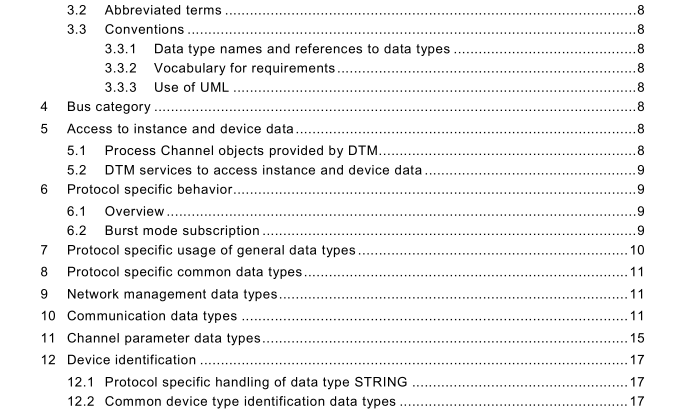IEC 62453-309:2009 pdf download – Field device tool (FDT) interface specification – Part 309: Communication profile integration – IEC 61784 CPF 9
5 Access to instance and device data
5.1 Process Channel objects provided by DTM
The minimum set of provided data shall be:
• the first four provided process related values (PV, SV, …) – if available – are modeled as channel references. The referenced channel shall include ranges and scaling.
5.2DTM services to access instance and device data
The services InstanceDataInformation and DeviceDataInformation shall provide access to atleast to all parameters of the Universal and Common Practice commands (as far as the devicesupports the function).
Furthermore,the Response Byte 0 and the Response Byte 1 for each command shall beexposed.
The services InstanceDatalnformation and DeviceDatalnformation may also provide access todevice specific parameters (e.g. diagnostic information).
6Protocol specific behavior
6.1overview
There is only one protocol specific sequence defined for lEC 61784 CPF 9:. burst mode subscription.
This sequence explains how the sequence “”, defined in Part 2 of this standard, is applied incontext of burst telegrams as defined by lEC61784 CPF 9.
6.2Burst mode subscription
A subscription to device initiated data transfer can be requested by sending a transactionrequest with SubscribeRequest content (see Figure 2). The Communication Channel maydetect if the device is already in burst mode.
NOTE In HART 5 this can be detected only when burst frames are received from the device. In HART 6 the burstmode can be detected using command 105.
The Communication Channel answers to a SubscribeRequest with a SubscribeResponsecontent. lf burst frames are received,the device is in burst mode and burstModeDetectedvalue is set to TRUE.This means that Device DTM will start to receive burst messages via thetransaction response mechanism. In the case that no burst messages were received,burstModeDetected value is set to FALSE. It is up to Device DTM to set device into burstmode.Then Device DTM may call a transaction request with SubscribeRequest content againin order to receive burst messages.
In order to unsubscribe, the Device DTM sends a transaction request with aUnsubcribeRequest. The Communication Channel answers with a SubscribeResponse whereburstModeDetected value is set to FALSE.The Device DTM will not receive any more burstinformation via the transaction response mechanism.The Communication Channel does notswitch off the burst mode in the device.The Device DTM may switch burst mode on or off byusing normal transaction requests (command 109).This is independent of the subscription.
7 Protocol specific usage of general data types
The following table (Table 2) shows how general data types, defined in IEC 62453-2 within the namespace ‘fdt’, are used with HART devices.IEC 62453-309 pdf download.
